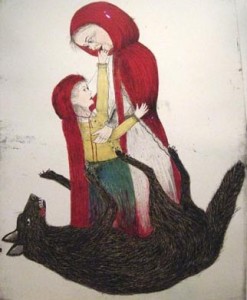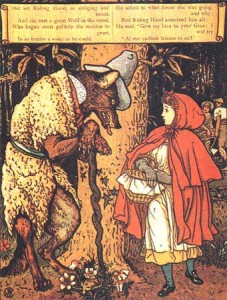In my paper presented at the ID-Net Conference on Play this past July I wrote about Kieran Egan‘s theory of imagination and how young children think about the world differently based on their imaginative schemas. Specifically I focused on the mythic and imaginative forms of thinking. I chose the fairy tale of Little Red Riding Hood to explore the ways in which even very young children abstract big ideas from their stories. Simply looking at images of Red Riding Hood can open up fascinating doors for reflection. For example, take these two illustrations/art works:
Each image offers up a world. Kiki Smith depicts the grandmother and Little Red Riding Hood as emerging from the body of the wolf. Women have often been associated with animals, the material and sensuous (wild, non-rational) nature. The red of the cape emerges out of the blood of the wolf: death, life–the bleeding that women experience and that terrifies the male psyche. From Crane’s traditional portrait of the girl meeting the wolf we recognize the wolf as male- as threatening to the girl. He wears the veneer of civilization in his clothing but the tail, sharp teeth, and lolling tongue betray his lustful and destructive nature. As Egan guides us we recognize the big binary ideas of male/female, human/animal, death/life, safety/danger. Young children grasp the import of these stories as far broader and deeper than simply amusing tales of long ago and far away.
For one more fascinating rethinking of the Little Red Riding Hood story, check out this video. I thank the Blogger on Dog Art for finding this creative revisiting.


